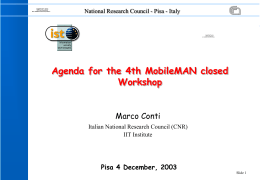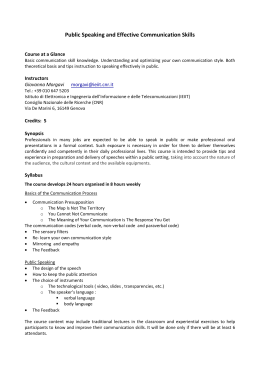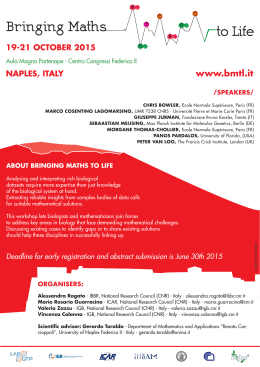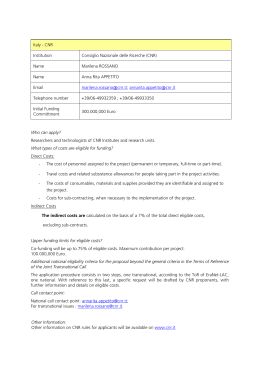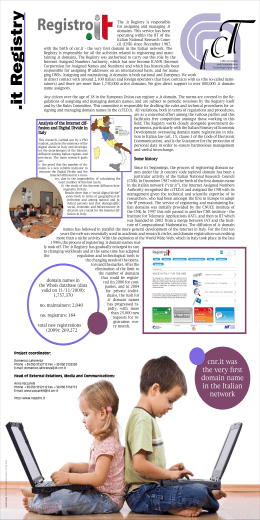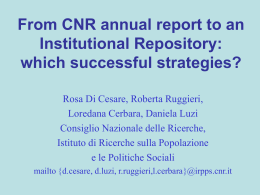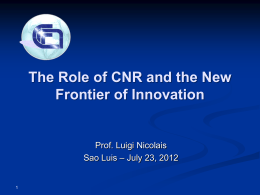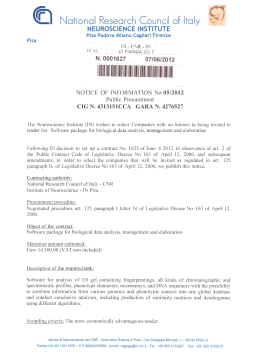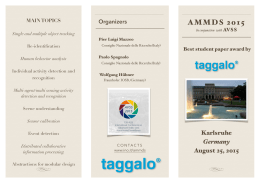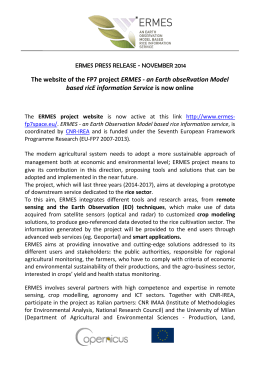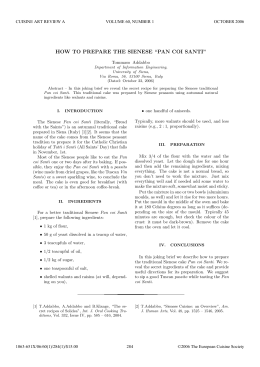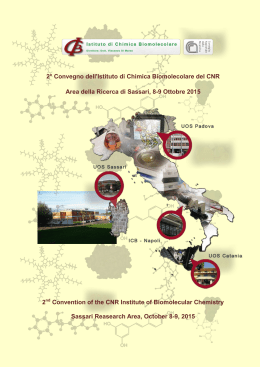Modeling and Simulation of Complex Systems The ubiquity of complexity has tremendous consequences for the future of science, technology, and in a sense our whole world view. T C This research Project aims at the development of models and methods for representing, simulating, monitoring and controlling systems and processes. The main characteristic of the systems and the processes under consideration is complexity, in its various aspects, such as: the existence of highly (Stephen Wolfram) nonlinear behaviors or of random phenomena, the coexistence of multiple scales, the large number of components and the multiplicity of their interconnections, the CNR Information knowledge incompleteness of the underlying mechanisms, the larand Communication ge sets of data. In investigating complex systems a multisectorial / interdiscipliTechnology Department nary approach and advanced techniques are mandatory and represent the core of the present Project. The Project “Modeling and Simulation of Complex Systems” of the ICT Department of CNR aims at integrating the various aspects that enable to characterize complex systems. The research activities focus on the development of tools which can be considered as bricks for the studies of complex systems and can be classified into the following areas: Models, Algorithms and Data. The Project covers different modeling and algorithmic aspects, both deterministic and stochastic, of some complex problems related to the Future Internet. The ComWatch system for Advanced Strategic Data Mining in the Web • Wireless Network Algorithms Investigation of some fundamental properties of wireless multi-hop networks: connectivity, radio interference, network lifetime, mobile node spatial distribution, safety-critical message propagation, network overhead, etc... Definition of simplified models, yet detailed enough to capture the most relevant features of real networks, and usage of these models to study both analytically and through simulation the fundamental tradeoffs involved in the considered network properties. Current Focus. Individual MObile NETworks (IMONETs), Wireless Mesh Networks, MIMO-based Networks (MIMONets). • • • Expected Results • • • Uncover fundamental structural properties of the considered networks Demonstrate how MIMO antennas, considered network resources, can be used to provided breakthrough throughput increase New communication paradigms specifically designed for the given network • Active Projects IPERMOB - www.ipermob.org MimoNet - www.iit.cnr.it/staff/paolo.santi/mimonet The objective of the Strategic Data Mining is that of extracting useful information on current trends that are not easily found in a single site or from a single source, that are relevant both for Public Policy and for Business Intelligence The World Wide Web is a vast, very rich, and very non homogenous repository of social information The ComWatch (Community Watch) system under development at IITCNR aims at extracting useful data for strategic data mining in the Italian national ccTLD domain “.it” (estimated size about 550M pages and 5G Links as of November 2009) Novelty: Separation of textual content from hypertextual content. Analysis of the hypertextual content so to find areas of high density of “links” thus more interesting for the analysis. This activity involves advanced algorithms for very large matrix and graph computations, including approximating NP-hard problems such as clique detection and sub-graph isomorphism. Textual analysis is done for each Community of Pages in order to extract keywords that classify them in commercial/social categories Specific questions can be investigated in ComWatch, for example: Which communities of pages deal with, say, Mobile Phones? Which communities are focused on local city council issues? Contact Person: Marco Pellegrini, IIT–CNR [email protected] Contact Person: Paolo Santi, IIT–CNR [email protected] Web usability • VISTO: Automatic extraction of highlights for video browsing and indexing • • • • • Motivation: The widespread use of low cost video devices and the increase of the available bandwidth fuel a rapid increase of the amount of video data accessible through the World Wide Web Need: The phenomenon of “information overload” is becoming a common experience also in the realm of video data, thus rising challenging problem of providing an effective video browsing experience to users of video portals Answer: The VISTO project pursued at IITCNR involved the on-the-fly creation of indexable, browsable and personalized video summaries (i.e. a concise sequence of frames/scenes representing the video storyline) Novelty: On-the-fly computation makes it possible to provide a customizable service to the end user, where users can define preferences (for, say , frames with people vs. landscapes or fast action vs. static scenes) and constraints on the feedback speed and length/accuracy of the coverage A demo of some functions of the VISTO system is available at http://visto. iit.cnr.it/ Contact Person: Marco Pellegrini, IIT–CNR [email protected] I think the next century will be the century of complexity. • Motivation: In e-commerce usability is related to navigation history by visitors finalized to purchase website deliverables Usability of web pages analyzed by statistical analysis of data extracted from server logs (Stephen Hawking, January 2000) E-Democracy • Motivation: e-democracy applications require tools for combining different source of information and opinions in an automatic way • Probabilistic and statistical methods have been developed in different contexts Contact Person: Fabrizio Ruggeri, IMATI-CNR [email protected] Automatic classification of digital images • • Motivation: optimal color processing in image reproduction; better organization and retrieval of images databases Implemented a classification technique based on Decision Forests obtaining a misclassification rate < 7% concerning close-ups only Readability of text in Web pages • • • • Motivation: identification of factors rendering reading of text easy in colored Web pages on displays under generic viewing conditions psychophysical experiments performed on the Web instead of laboratory setting Luminance contrast found to be the dominant factor to ensure readability Identified in 30 units of lightness difference the threshold for a comfortable reading Contact Person: Carla Brambilla, IMATI-CNR [email protected] Research Units High performance algorithms for large scale scientific computing Nicola Mastronardi – IAC, Bari Data mining, identification and estimation of complex systems Giovanni Felici – IASI, Roma Control and optimization of complex systems - Claudio Gentile – IASI, Roma Mathematical models and numerical methods for flight dynamics and solid mechanics - Luciano Anselmo – ISTI, Pisa Development of mathematical and statistical methodologies and of the related software tailored for grid computing - Umberto Amato – IAC, Napoli Innovative modeling methods for multiscale and/or incompletely known systems - Liliana Ironi – IMATI, Pavia Efficient methods and algorithms for the solution of complex problems - Paola Favati – IIT, Pisa Evolutionary computing methodologies and tools and their application to modeling and optimization in complex systems - Ivanoe De Falco – ICAR, Napoli Project coordinator: Gianni Sacchi Phone: +39 0382 548211 Fax: +39 0382 548300 E-mail: [email protected] Innovative compatible discretization techniques for Partial Differential Equations - Annalisa Buffa – IMATI, Pavia Artificial Societies and Social Simulation - Mario Paolucci – ISTC, Roma Graphic Design: Patrizia Andronico, Segreteria Scientifica, IIT-CNR, 200911 Stochastic system modeling - Bruno Betrò – IMATI, Milano
Scarica
